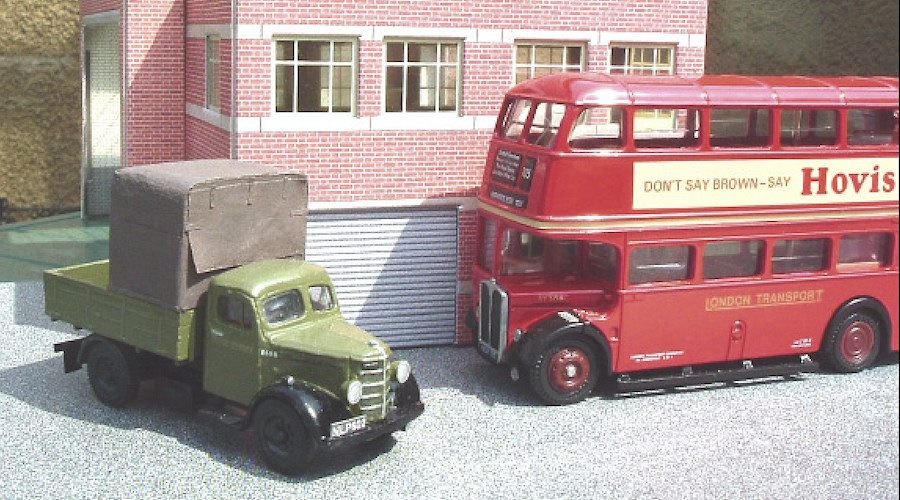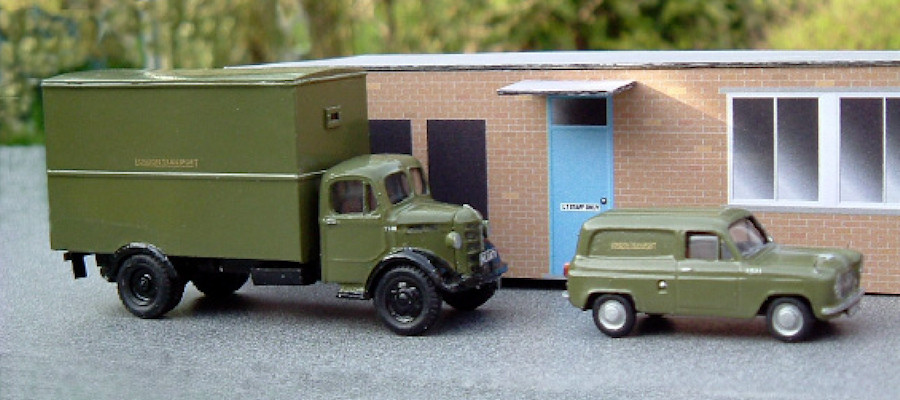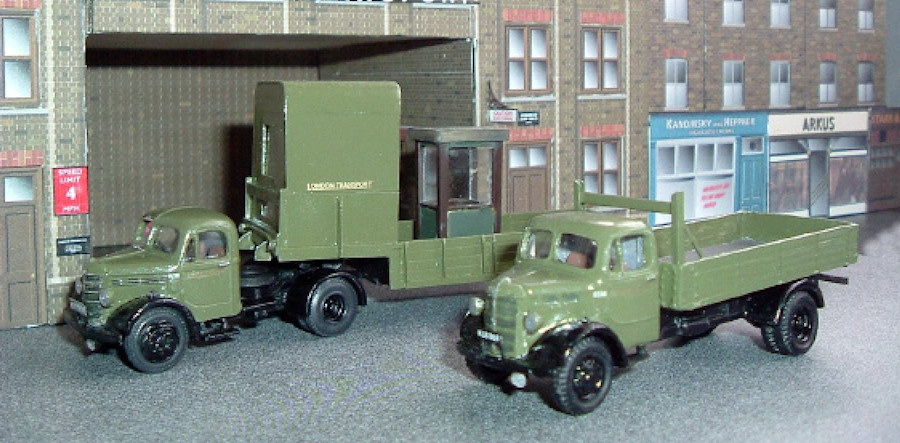
View Latest Data |

|
Log-in Register |
||||||||||
| Title: | Modelling LT Service Vehicles in 1:76 scale. Part 2: Bedford Lorries |
| Summary: | PDF. Three excellent photographs of model SVs, with some notes and tips. |
| Category: | Modelling |
| Author: | Clive Greedus |
| Posted: | 16/06/2004 |
| Last updated: | 16/06/2004 |
| Download: | article012.pdf |
| Content: |
London Transport Service Vehicles in Miniature – June 2004
update
By Clive Greedus  A typical LTE garage scene till the Thames Traders took over in the early sixties finds 868B, one of the Bedford KD half tilts, alongside one of the RT buses which many of them supported by ferrying spares between garages. 'Coopercraft' Bedford ML dropside lorry
This is an ideal basis for the KD 30cwt half tilts that so many bus garages used and also possibly for the KZ 30cwt vans. Its a bit fiddly and delicate to make, but is excellent value and can produce a charming and quintessential London Transport vehicle.
The kit is of a larger 2 ton vehicle but can be converted to a 30cwt KD by shortening both chassis and body at the front end and by using single 'rear' pattern wheels all round. For the extra wheels and an extra 'front' axle for the rear singles, you will need to buy two kits, but they are very cheap, and some parts will be useful for other models. The kit even includes flush glazing, though for the side windows I preferred to use clear acetate to avoid the 'thick spectacles' look, and this enables quarter lights to be added from plastic strip. The tilt can be scratchbuilt from plastic card, Milliput filler, and an embossed masking tape to simulate the canvas tilt texture. Some details such as the front numberplate and spotlight varied between individual vehicles, and in this case Murphy's law decreed that after I had fitted the numberplate in the usual position in front of the radiator, I found a photo of the actual lorry with it on the offside bumper, so I had to move it!
 Another load of Griffin tea and LTE shortcake biscuits arrives at the canteen in Bedford OLBC catering van, 714B, but it may be a sixties version of Hell's Kitchen inside if Ford 100E van, 1153F is attending to a plumbing problem!  In my view, the 'beast' of fifties service vehicles was 953B, a Bedford OSS coupled with an Eagle 8 ton low loading trailer fitted with an enormous metal tilt. Here it is hardly tested carrying this ticket collector's box, whilst standing alongside is 831B, a less exotic OLBC dropside lorry with metal bolster. (I just hope they get busy removing those bricks from the garage entrance before the evening peak!) 'Canterbury Miniature Commercials' Bedford OLBC lorry
Along with the Regal and Regent bus conversions, the Bedford O series, was the standard LT lorry of the early postwar period. This kit follows the usual Canterbury format of one piece cab, one piece body and one piece chassis, which makes it a straightforward assembly job. Although not up to the high quality of the late lamented Roadscale kit (as used for the prime mover of 953B above), it is a far better prospect than the Springside version which I have declined to build as it comes in so many unnecessarily small parts and lacks any refinements.
Canterbury models just lack moulded windows or printed screens, and this kit benefits from the removal of some metal from the inside of the cab to provide a flusher fit for glazing. It is also worthwhile drilling and filing to make a gap between the cab doors and footsteps.
A front number plate can be made and placed in front of the radiator on a bracket made from a rebent staple fixed into holes drilled in the bumper. An easy source of registrations can be made by printing them off a computer, and I have made up an Excel sheet for this purpose. At the rear end of the kit, lights and a registration plate are also needed.
To make a typical 50s LT style bolster, one needs 1/32 inch brass channel for the uprights, with thin strips for the diagonal supports, and plastic strip for the crossbar.
Other bodies have to be scratch built from pastic card with micro strip for detailing. The Scammell
coupling of 953B came from a Dapol mechanical horse trailer and required a new pivot hole on the prime
mover just behind the axle. Sounds wrong, but unlike models, the coupling on the prototype was held tight and swivelled on the trailer. The small trailer wheels came from a Sherpa van, and are available separately from ABS, but the overall accuracy of these projects is mainly dependent on the photographs available.
This article is also available as a downloadable PDF. To view the file, left-click the link below. To download the file, right-click the link and select 'Save link as...'. article012.pdf |